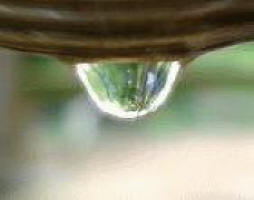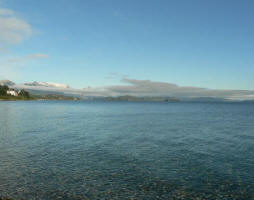 How much water is there on, in, and above the Earth?
How much water is there on, in, and above the Earth?
As you know, the Earth is a watery place. But just how much water exists on, in, and above our planet? About 70 percent of the Earth's surface is water-covered, and the oceans hold about 96.5 percent of all Earth's water. But water also exists in the air as water vapor, in rivers and lakes, in icecaps and glaciers, in the ground as soil moisture and in aquifers, and even in you and your dog.
Water is never sitting still, though, and thanks to the water cycle, our planet's water supply is constantly moving from one place to another and from one form to another. Things would get pretty stale without the water cycle!
All Earth's water in a bubble
This drawing shows various blue spheres representing relative amounts of Earth's water in comparison to the size of the Earth. Are you surprised that these water spheres look so small? They are only small in relation to the size of the Earth. This image attempts to show three dimensions, so each sphere represents "volume." The volume of the largest sphere, representing all water on, in, and above the Earth, would be about 332,500,000 cubic miles (mi3) (1,386,000,000 cubic kilometers (km3)), and be about 860 miles (about 1,385 kilometers) in diameter.
The smaller sphere over Kentucky represents Earth's liquid fresh water in groundwater, swamp water, rivers, and lakes. The volume of this sphere would be about 2,551,000 mi3 (10,633,450 km3) and form a sphere about 169.5 miles (272.8 kilometers) in diameter. Yes, all of this water is fresh water, which we all need every day, but much of it is deep in the ground, unavailable to humans.
Do you notice that "tiny" bubble over Atlanta, Georgia? That one represents fresh water in all the lakes and rivers on the planet, and most of the water people and life of earth need every day comes from these surface-water sources. The volume of this sphere is about 22,339 mi3 (93,113 km3). The diameter of this sphere is about 34.9 miles (56.2 kilometers). Yes, Lake Michigan looks way bigger than this sphere, but you have to try to imagine a bubble almost 35 miles high—whereas the average depth of Lake Michigan is less than 300 feet (91 meters).
| Contact information |
Howard Perlman
|
|---|---|
| News type | Inbrief |
| File link |
http://ga.water.usgs.gov/edu/earthhowmuch.html |
| Source of information | The Hydrologic Cycle, USGS pamphlet, 1984 |
| Keyword(s) | water cycle |
| Subject(s) | AGRICULTURE , ANALYSIS AND TESTS , CHARACTERISTICAL PARAMETERS OF WATERS AND SLUDGES , DRINKING WATER , DRINKING WATER AND SANITATION : COMMON PROCESSES OF PURIFICATION AND TREATMENT , ENERGY , FINANCE-ECONOMY , HEALTH - HYGIENE - PATHOGENIC MICROORGANISM , HYDRAULICS - HYDROLOGY , INDUSTRY , INFORMATION - COMPUTER SCIENCES , INFRASTRUCTURES , MEASUREMENTS AND INSTRUMENTATION , METHTODOLOGY - STATISTICS - DECISION AID , NATURAL MEDIUM , POLICY-WATER POLICY AND WATER MANAGEMENT , PREVENTION AND NUISANCES POLLUTION , RIGHT , RISKS AND CLIMATOLOGY , SANITATION -STRICT PURIFICATION PROCESSES , SLUDGES , TOOL TERMS , TOURISM - SPORT - HOBBIES , WATER DEMAND , WATER QUALITY |
| Relation | http://ga.water.usgs.gov/edu/earthhowmuch.html |
| Geographical coverage | n/a |
| News date | 08/06/2012 |
| Working language(s) | ENGLISH |
 you are not logged in
you are not logged in





